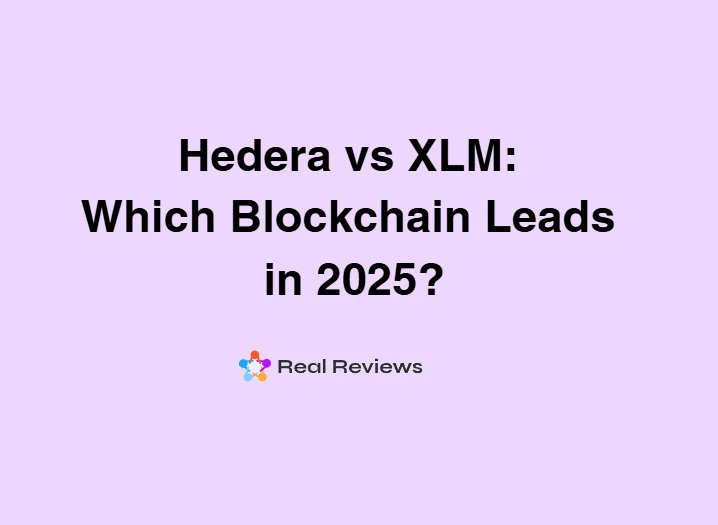
Hedera vs XLM: Which Blockchain Leads in 2025?
The times when you only had a few crypto investment options are long gone. Today, numerous exciting projects are emerging with innovative ideas to improve the digital economy. Our guide focuses on the HBAR vs XLM comparison. These have great potential for 2025, but which blockchain leads the way? Here are more details about both projects to help you understand their advantages and downsides!
Overview of Hedera Hashgraph
Hedera’s main feature is that it’s not a blockchain structure. Instead, the project uses a directed acyclic graph (DAG) data setup. Apart from a different structure, the primary characteristics remain the same. The transactions are immutable, and their data remains stored in this structure.
A special Hedera Hashgraph consensus validates transactions. The process used a “gossip” system to maximize efficiency while preserving optimal security. Thanks to the aBFT consensus mechanism, consensus is reachable even when there are malicious or erroneous nodes.
Hedera can process thousands of transactions per second. That rate ensures impressive speed in settling transactions, often completed in seconds. It’s also worth noting that Hedera benefits from horizontal scaling. That ensures that the performance isn’t affected by network growth.
As for governance, the Hedera Council is how the network is operated. Global organizations like Google and IBM participate in the council. However, the design guarantees that no single entity, whether it’s a company or developer, has major control over the network.
Hedera has numerous use cases across different industries. HBAR is becoming more popular in the decentralized finance industry, while Hedera is also suitable for supply chain management and other applications.
Overview of Stellar (XLM)
Stellar is a digital payment method specially designed for international and microtransactions. Its similarity with XRP doesn’t end there because its cofounder, Jed McCaleb, also participated in establishing Ripple.
XLM is the blockchain’s native coin. Its primary purpose is to serve cross-border payments, offering a simpler alternative to fiat money when sending funds worldwide. The network uses a special Stellar Consensus Protocol. It eliminates mining, which lowers resource use. As a result, the transactions are validated quickly, and users pay a minor fee. In fact, XLM is among the networks with the lowest fees out there.
Stellar use cases can go beyond international transactions. The network partners with reputable institutions like World Wire by IBM to expand its acceptance. However, Stellar remains most popular in developing countries and locations where traditional banking isn’t that accessible. XLM is worth around $0.45 per coin at the moment. Check out HBAR price prediction 2025 to learn about this currency’s specifics for the coming year.
Hedera vs Stellar: Feature Comparison
Let’s compare Hedera and Stellar across four major categories:
- Performance. Hedera’s rate of thousands of TPS is higher than that of standard blockchains. Thanks to horizontal scaling, Hedera is a great option for enterprises. Stellar can also handle a large number of transactions, with an estimated TPS of about 3,000. While it’s not as scalable as Hedera, it’s decent for international payments and most financial requirements.
- Security. Both networks are highly secure, and that’s one of their major characteristics. Although they have different consensus protocols, the safety level is impressive for both Hedera and Stellar.
- Ecosystem and partnerships. With platforms like Dell and LG in the council, Hedera only needs to maintain current partnerships. It has excellent credibility, and the network continues to expand its ecosystem. As for Stellar, it primarily focuses on partnering with more financial institutions to adopt the XLM currency as a payment method. Its partners are also reputable, and companies like Circle and Deloitte are on the list.
- Cost efficiency. From an investor’s perspective, XLM transaction fees are surprisingly low. That’s why this network is ideal for micropayments and cross-border transactions. That doesn’t mean Hedera is expensive because the network offers affordable pricing compared to most blockchains.
Hedera vs XLM: The Blockchain Winner
Stellar and Hedera are close to each other in the market cap rankings. Hedera is unique because it uses the DAG structure, which enables excellent scalability. Stellar focuses primarily on being a viable digital payment method on international level. Both platforms have reputable institutions like IBM as partners, so they seem like serious projects. It all depends on which type of investment you prefer. XLM is excellent if you want to focus on a digital payment method, while Hedera has more versatile use cases across different industries. Ultimately, the decision is yours, so pick according to your portfolio requirements.




